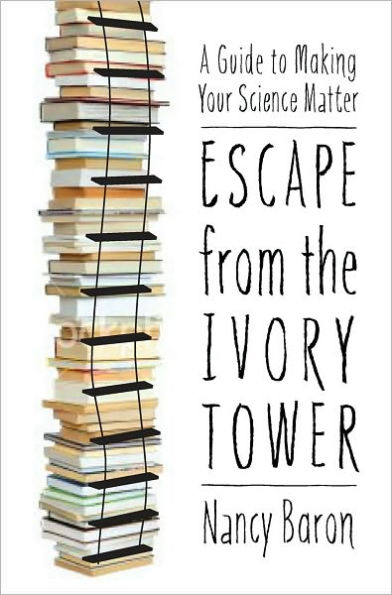Escape from the Ivory Tower: A Guide to Making Your Science Matter
Most scientists and researchers aren’t prepared to talk to the press or to policymakers—or to deal with backlash. Many researchers have the horror stories to prove it. What’s clear, according to Nancy Baron, is that scientists, journalists and public policymakers come from different cultures. They follow different sets of rules, pursue different goals, and speak their own language. To effectively reach journalists and public officials, scientists need to learn new skills and rules of engagement. No matter what your specialty, the keys to success are clear thinking, knowing what you want to say, understanding your audience, and using everyday language to get your main points across. In this practical and entertaining guide to communicating science, Baron explains how to engage your audience and explain why a particular finding matters. She explores how to ace your interview, promote a paper, enter the political fray, and use new media to connect with your audience. The book includes advice from journalists, decision makers, new media experts, bloggers and some of the thousands of scientists who have participated in her communication workshops. Many of the researchers she has worked with have gone on to become well-known spokespeople for science-related issues. Baron and her protégées describe the risks and rewards of “speaking up,” how to deal with criticism, and the link between communications and leadership. The final chapter, ‘Leading the Way’ offers guidance to scientists who want to become agents of change and make your science matter. Whether you are an absolute beginner or a seasoned veteran looking to hone your skills, Escape From the Ivory Tower can help make your science understood, appreciated and perhaps acted upon.
1110864402
Escape from the Ivory Tower: A Guide to Making Your Science Matter
Most scientists and researchers aren’t prepared to talk to the press or to policymakers—or to deal with backlash. Many researchers have the horror stories to prove it. What’s clear, according to Nancy Baron, is that scientists, journalists and public policymakers come from different cultures. They follow different sets of rules, pursue different goals, and speak their own language. To effectively reach journalists and public officials, scientists need to learn new skills and rules of engagement. No matter what your specialty, the keys to success are clear thinking, knowing what you want to say, understanding your audience, and using everyday language to get your main points across. In this practical and entertaining guide to communicating science, Baron explains how to engage your audience and explain why a particular finding matters. She explores how to ace your interview, promote a paper, enter the political fray, and use new media to connect with your audience. The book includes advice from journalists, decision makers, new media experts, bloggers and some of the thousands of scientists who have participated in her communication workshops. Many of the researchers she has worked with have gone on to become well-known spokespeople for science-related issues. Baron and her protégées describe the risks and rewards of “speaking up,” how to deal with criticism, and the link between communications and leadership. The final chapter, ‘Leading the Way’ offers guidance to scientists who want to become agents of change and make your science matter. Whether you are an absolute beginner or a seasoned veteran looking to hone your skills, Escape From the Ivory Tower can help make your science understood, appreciated and perhaps acted upon.
28.0
In Stock
5
1

Escape from the Ivory Tower: A Guide to Making Your Science Matter
240
Escape from the Ivory Tower: A Guide to Making Your Science Matter
240
28.0
In Stock

Product Details
| ISBN-13: | 9781597266642 |
|---|---|
| Publisher: | Island Press |
| Publication date: | 08/20/2010 |
| Edition description: | 1 |
| Pages: | 240 |
| Product dimensions: | 5.90(w) x 8.90(h) x 0.70(d) |
About the Author
From the B&N Reads Blog
